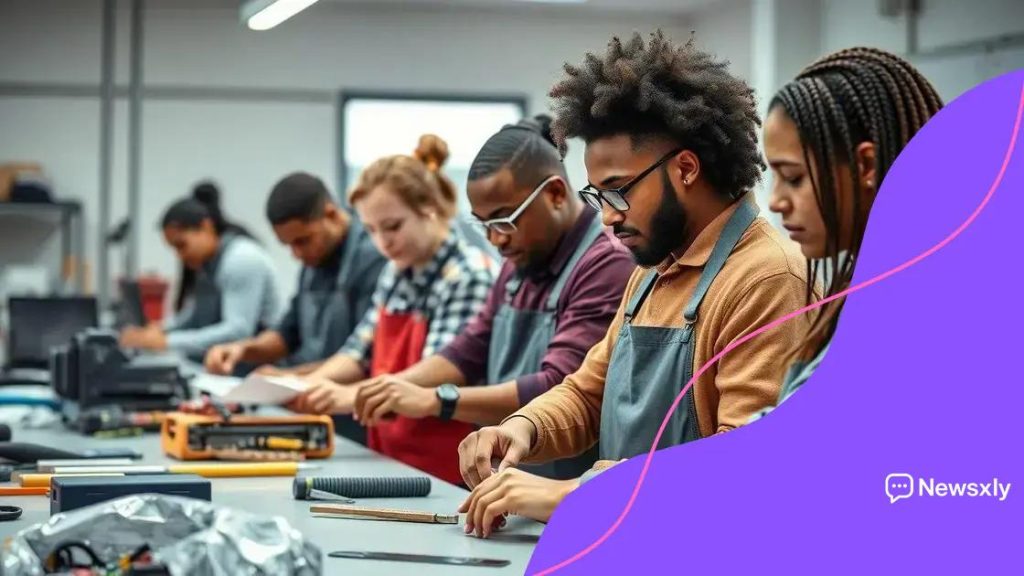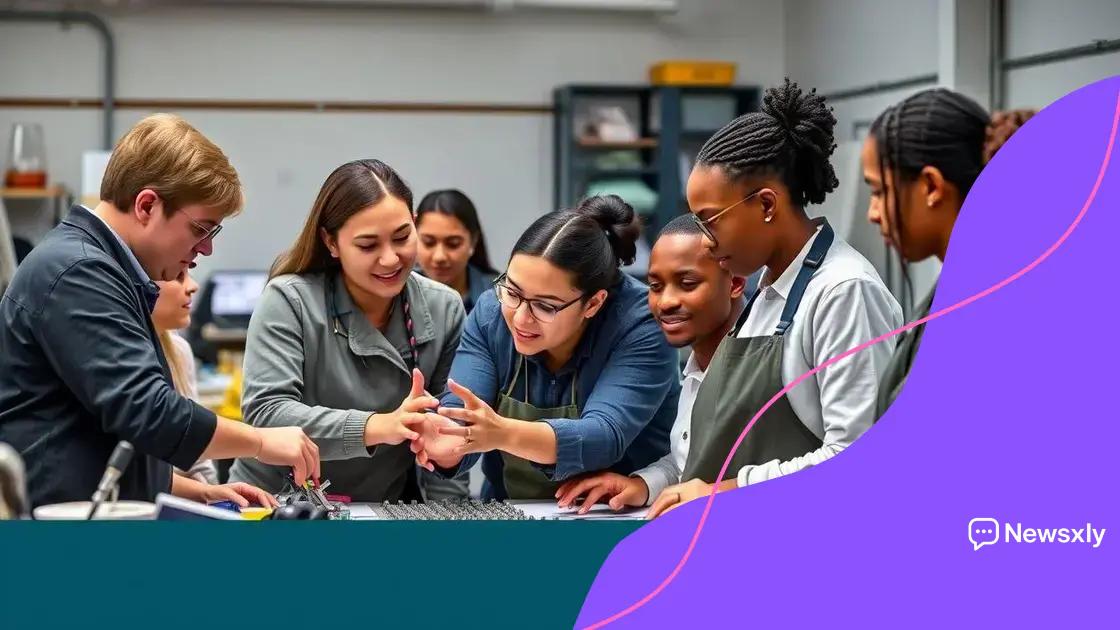The future of vocational education: what lies ahead

The future of vocational education focuses on integrating technology, emphasizing lifelong learning, and developing both technical and soft skills to meet evolving job market demands.
Have you ever considered how the future of vocational education could reshape career paths? With rapid changes in technology and workforce needs, it’s an exciting time to explore how educational systems adapt to these shifts.
Understanding the current landscape of vocational education
Understanding the current landscape of vocational education is crucial for students and employers alike. In recent years, this sector has undergone significant changes, adapting to new market demands and technologies. With a focus on practical skills, vocational education prepares students for the workforce in a way that traditional academic routes may not.
Current Trends in Vocational Education
Today, vocational programs are becoming more inclusive, providing access to a broader range of students. Factors like digital transformation and changing job markets are reshaping these programs. Institutions are incorporating modern technology and innovative teaching methods to equip students better.
- Integration of Technology: Vocational schools now use simulations and online training.
- Industry Partnerships: Collaborations with businesses ensure that the curriculum meets job requirements.
- Focus on Soft Skills: Many programs now teach skills like teamwork, communication, and problem-solving.
These changes help students gain not just technical knowledge but also the confidence and skills needed to excel in their fields. The emphasis is shifting towards a hands-on, experiential learning model that is highly effective for skill acquisition.
Challenges in the Vocational Education Landscape
Despite the progress, there are challenges to consider. Funding and resources can be limited in some areas, leading to disparities in program quality. Additionally, societal perceptions of vocational education can impact enrollment numbers. Many still associate it with inferior academic pathways, which isn’t the case.
To tackle these challenges, awareness campaigns and initiatives aimed at changing perceptions are essential. By highlighting success stories of vocational education graduates, it becomes easier to encourage a new generation of students to consider these valuable programs.
With the labor market continually evolving, understanding the current landscape of vocational education is vital for students aiming for success. By staying informed, they can make better choices for their futures.
Emerging technologies shaping vocational training
Emerging technologies are reshaping the way vocational training is delivered. With advancements in technology, vocational education can now be more interactive and engaging. Innovations like virtual reality (VR) and augmented reality (AR) are making hands-on training more accessible and effective. Students can practice skills in simulated environments that closely mimic real-life situations.
Key Technologies in Vocational Training
Various technologies are influencing the current landscape of vocational training. These include:
- Virtual Reality: Provides immersive training experiences.
- Online Learning Platforms: Offers flexibility and accessibility for students.
- Mobile Applications: Allows for learning on-the-go and easy access to resources.
- 3D Printing: Helps in creating prototypes and teaching design techniques.
These technologies offer students the opportunity to learn and practice in safe environments, enhancing their understanding and skills. For instance, VR allows students to experience complex scenarios that would be difficult to replicate in a traditional classroom.
The Impact of AI on Vocational Education
Artificial Intelligence (AI) is also making strides in vocational training. AI can personalize learning experiences by assessing each student’s strengths and weaknesses. This allows for tailored educational paths that cater to individual needs. Additionally, AI can help instructors monitor progress in real-time, providing feedback and support as needed.
As these technologies integrate into vocational programs, they bring exciting opportunities for both educators and students. By staying on the cutting edge of technology, institutions can prepare students for the demands of the modern workforce, ensuring that they have the skills necessary to succeed.
The role of partnerships in vocational education

The role of partnerships in vocational education is essential for creating effective programs. Collaborations between schools, businesses, and community organizations help to align training with real-world needs. These partnerships ensure that students receive relevant skills that employers demand.
Benefits of Partnerships
Building strong connections brings numerous advantages. Some key benefits include:
- Enhanced Training Programs: Companies can provide input on the skills needed in the workforce.
- Internship Opportunities: Students gain real-life experience, making them more job-ready.
- Resource Sharing: Schools can access additional funding, materials, and expertise.
- Curriculum Development: Employers can help design courses that reflect current industry standards.
These benefits not only enhance the quality of education but also bridge the gap between learning and employment. When students engage with community partners, they develop practical skills that prepare them for future careers.
Successful Examples of Partnerships
Many vocational programs worldwide demonstrate the power of collaboration. For instance, some local schools are partnering with tech companies to provide students with access to the latest tools and software. These initiatives often lead to job placements for students who complete their training with respected organizations.
Programs that involve real businesses allow students to network and build relationships that can lead to future employment. These partnerships are vital in creating a skilled workforce suited to meet local economy demands.
Skills employers are seeking in vocational education graduates
Skills employers are seeking in vocational education graduates are more important than ever. As industries evolve, so do the requirements for job candidates. Employers are looking for candidates who not only possess technical abilities but also demonstrate strong interpersonal skills.
Essential Technical Skills
Graduates must have the right technical skills to meet job demands. Some of the essential skills include:
- Hands-on Experience: Practical knowledge in their field through internships or training programs.
- Familiarity with Technology: Understanding and using industry-specific software and tools.
- Problem-Solving Skills: Ability to analyze situations and propose effective solutions.
- Health and Safety Standards: Knowledge of regulations and best practices in workplace safety.
Technical skills are the foundation of vocational education, ensuring that graduates can contribute effectively to their workplaces from day one.
Important Soft Skills
Along with technical abilities, employers also value soft skills. These include:
- Communication: Clear and effective communication with colleagues and clients.
- Teamwork: Ability to work well with others in various settings.
- Adaptability: Willingness to learn and adapt to new challenges in the workplace.
Soft skills are vital for fostering a productive work environment. Employers appreciate when graduates can collaborate, share ideas, and contribute positively to a team. As workplaces become more diverse, the ability to connect with others and work harmoniously is increasingly important.
By focusing on both technical and soft skills, vocational education prepares graduates to meet the demands of the job market effectively. This balanced skill set empowers students to be competitive and successful in their future careers.
Future trends and predictions for vocational education
Future trends and predictions for vocational education highlight the continuous evolution of the field. As industries change and technology advances, vocational education must adapt to prepare students for upcoming challenges and opportunities.
Integration of Technology
One major trend is the increasing integration of technology into vocational programs. Online learning platforms will become more common, allowing students to access courses anytime, anywhere. Schools will adopt advanced tools like virtual reality (VR) for training simulations, making lessons more interactive and engaging.
- Online Certifications: More programs will offer certifications through online platforms.
- Utilization of AI: AI will help personalize learning experiences based on student performance.
- Collaboration with Tech Firms: Partnerships with technology companies will enhance curriculum relevance.
This tech-driven approach will not only make education more accessible but will also align training with current and future job market demands.
Emphasis on Lifelong Learning
Another prediction for the future is the growing need for lifelong learning. As careers evolve, workers will need to continuously update their skills. Vocational education will likely focus on providing flexible learning paths that accommodate individuals at different stages of their careers. This means more short courses and workshops aimed at skill enhancement.
Educational institutions will shift towards a model that supports adult learners, allowing them to gain new skills while maintaining their current jobs. This adaptability will ensure that workers remain competitive and knowledgeable.
Globalization of Vocational Education
The globalization of vocational education is also anticipated. As companies operate on a global scale, the need for a workforce that understands international standards and practices will increase. Programs will begin to emphasize cross-cultural skills and training, preparing students for a diverse work environment.
By understanding global trends, vocational educators can equip their students with the tools needed to succeed in various cultural contexts, thus broadening their career opportunities.
In summary, the future of vocational education is promising and filled with opportunities for students and industries alike. As we move forward, it’s clear that emerging technologies, partnerships, and an emphasis on both technical and soft skills are crucial. Vocational education will continue to evolve, adapting to the changing job market and ensuring students are well-equipped for success. By focusing on lifelong learning and global perspectives, vocational programs can empower graduates to thrive in diverse workplaces.
\n\n
\n
FAQ – Frequently Asked Questions about the Future of Vocational Education
What are some emerging technologies in vocational education?
Emerging technologies include virtual reality (VR), artificial intelligence (AI), and online learning platforms that enhance the educational experience.
Why is lifelong learning important in vocational education?
Lifelong learning ensures that individuals continuously update their skills to remain competitive in a rapidly changing job market.
How do partnerships with businesses benefit vocational programs?
Partnerships with businesses provide valuable insights into industry needs, offer internship opportunities, and help develop relevant curricula.
What skills are vocational education graduates expected to have?
Graduates should possess both technical skills specific to their field and essential soft skills like communication, teamwork, and adaptability.





